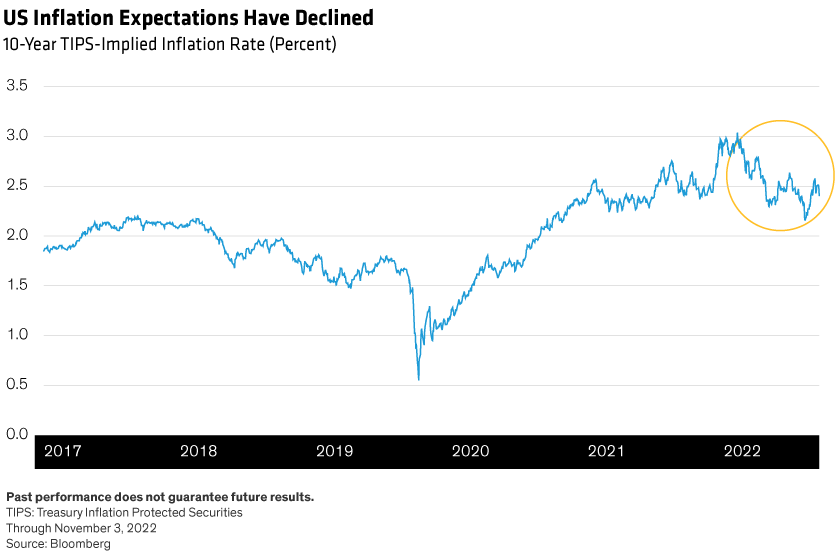The Federal Open Market Committee (FOMC) raised its benchmark interest rate by 75 basis points at its November meeting to a 3.75%–4.00% range—the highest in 15 years. The FOMC also indicated that more rate hikes are likely, though they’ll likely be smaller than the super-sized hikes of the last few months.
Other central banks have taken similar steps, with a few having already slowed the pace of hikes—even with inflation still running red hot. Why slow down now? The Fed’s process to bringing inflation down provides the answers—and it plays out in three phases.
Phase One: Get the Policy Rate Higher—Fast
Central banks first consider the policy setting relative to the “neutral” interest rate. Anything below neutral will boost growth and inflation. The Fed currently estimates the neutral rate to be 2.5%–3.0%; with inflation surging early this year, policy rates below that level were obviously the wrong setting. The more the dial stayed there, the more likely inflation would accelerate and push expectations up. To fix the issue, the Fed, and almost all other central banks, went into emergency mode with huge rate hikes.
With policy rates now meaningfully above neutral, the first phase of the tightening process is finished—and apparently successful. The Fed showed that it was serious about fighting inflation even at the cost of financial market turbulence. Inflation expectations have not only stayed well-anchored, they’ve fallen (Display). Inflation is still very high, but the Fed’s credibility is intact—that’s critical to its ability to manage the economy going forward.

Phase Two: Continued—but Slower—Rate Hikes
With the Fed’s credibility intact, it can move to a new phase: rolling out more rate hikes but at a slower pace. The policy rate is above neutral, providing good reason to slow down, and stable inflation expectations enable the downshift.
Monetary policy works with a long lag: today’s rate hikes won’t change inflation tomorrow, but they will change it nine to 12 months from now. The first of the rate hikes was only eight months ago, so the Fed needs to see how those ingredients change the mix before deciding how much further to go. Without that feedback, it risks going too far and causing a needlessly severe recession, rather than the milder one we think will be enough to bring inflation down over time. Taking it slower near the end of the cycle means less chance of a policy overshoot.
The FOMC was explicit last week that it’s transitioning into this second phase, indicating that, in addition to monitoring incoming data, it will “take into account the cumulative tightening of monetary policy, [and] the lags with which monetary policy affects economic activity and inflation.”
That language is new, and we read it as a clear hint that a smaller hike might be in store next. We forecast a 50 basis point hike in December, followed by 25 basis points in each of the first two meetings of 2023, which would raise the policy rate to 4.75%–5.00%. That path is consistent with our expectation that inflation will start to moderate soon, but if we’re wrong, we think it’s more likely the Fed will go farther, rather than faster. Higher inflation releases are more likely to lengthen the rate-hike cycle than accelerate it.
Other central banks are already moving down this path. The Bank of Canada downshifted from 75 basis point hikes to 50 at its last meeting, and both the Reserve Bank of Australia and Norges Bank have already slowed to a pace of 25 basis points per meeting. Once the Fed slows, we expect other central banks to follow suit.
Phase Three: Prolonged Restrictive Policy
Inflation is starting from a high level, so even if it moderates as we expect, it will still be a very long time before it returns to the 2.0% target. As a result, we expect the final phase of this tightening cycle to be an extended period of restrictive policy: the Fed will pause, but it won’t soon pivot. Even if the economy falls into a recession, we don’t think the Fed will be in a hurry to cut rates, and we expect the policy rate to stay far above neutral for many months, if not quarters.
That’s a change from past cycles, when the Fed has been quick to respond to slower growth. This time around, however, the magnitude of the inflation increase suggests a different path. A moderation in inflation will be enough to slow and eventually stop rate hikes, but the Fed won’t be willing to cut until inflation is nearly down to 2%. Only a much worse economic outcome and much sharper than expected inflation decline would push the Fed into rate cuts in the next few quarters.
From a big-picture perspective, markets might find some relief from a slower pace of interest-rate hikes, but investors should bear in mind that this only signals the end of phase one. There’s still a long way to go before this cycle is over.
Eric Winograd is Director of Developed Market Research at AllianceBernstein (AB).
The views expressed herein do not constitute research, investment advice or trade recommendations, and do not necessarily represent the views of all AB portfolio-management teams. Views are subject to change over time.